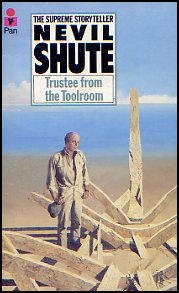Review: Trustee from the Toolroom by Nevil Shute
I first discovered this gem as a Reader’s Digest Condensed Book. That was over fifty years ago, long enough that I don’t remember what they removed to condense it. It doesn’t matter—the novel captured me even in its condensed form. I re-read it with great enjoyment at least once a year.
The story is a simple one, suited to its main character. Keith Stewart is a post-war aviation tool-fitter, living in a modest house on modest means supplied by his weekly Miniature Mechanic column about building model engines and clocks. To supplement this income, his wife works part-time in a shop. Shute tells us this basic fact about Keith Stewart right up front:
He would have made more money in the toolroom progressing up from charge-hand to foreman; he would have made more money as an instructor in a technical college. He would not have made more happiness than he had now attained.
The part of Keith’s “job” he likes least is the correspondence. Even so, he replies personally to each letter, equally patient with the able mechanic and the obvious novice (such as Mr. Hirzhorn of Tacoma, Washington, who “evidently had a secretary with an electric typewriter to whom he could dictate, because each letter was about fifteen hundred words long.”) The letters come from all over the world. Every engineer, tool-fitter, and tech of the day is building little engines; and most of them read Miniature Mechanic for the designs and instructions Keith supplies.
Keith and his wife have no children. His only sister Jo, who married well, has one, and while Jo and her husband are on a sailing vacation (actually scouting for a permanent move to Canada or the US Northwest), their daughter Janey will stay with Keith and Katie. Before they leave in their yacht, Keith helps them seal a small leather box into concrete in the ballast of the boat. He believes it carries Jo’s jewelry with them, because the currency-export restrictions would prevent it otherwise. Actually, he’s not too troubled about it. Keith is a man living in his comfort zone, and is not troubled about anything much.
Several months later, when they learn that Jo and her husband are dead in a shipwreck on a tiny island in the South Pacific, Keith and Katie realize that they will need to care for Janey. This is when Keith learns that his trusteeship will require more than faithfully caring for Jo’s daughter. The entire fortune the couple had amassed has been converted to diamonds, and Keith is the only living man who knows where those diamonds might be.
He decides he must recover them alone, and sets out to do just that, undertaking a journey to the opposite side of the globe. This modest man who has never been off the island of England packs a single small suitcase, puts a £110 in traveler’s checks in one pocket and a tiny model generator in the other, and talks himself onto a flight over the pole to Hawaii.
In Honolulu, he learns that the only ship heading anywhere near the tiny island he needs to reach is a dirty hand-built fishing ship owned by a “simple-minded man,” Jack Donnelly, who had sailed her alone from Oregon without charts, engine or any paperwork. Keith, who knows he suffers from sea-sickness, sets out across the emptiest part of the Pacific as second hand to Donnelly.
Behind the scenes, however, Keith is anything but alone. His editor at Miniature Mechanic worries that this mainstay of his publication may come to grief. He sends a telegram to a professor in Michigan whose model-building is the technical relief from his professional focus on medieval literature. The professor considers who may be able to help, and passes the telegram to the Tacoma lumber magnate, Sol Hirzhorn, who has his own reasons for helping Keith Stewart.
Hirzhorn makes loaning Keith the use of the Ferris yacht (which happens to be in Honolulu) part of a million-dollar deal Hirzhorn is contemplating with Chuck Ferris of Ferris Hydraulics. Pilots, mechanics, engineers, and model-builders—makers and movers—whom Keith meets all along the way each lend a hand to help him. Through their (and his own) willingness to help, Keith is brought to realize his own value and abilities.
In the end, this is a novel about networking, about the community of makers, and about real virtue rewarded. As for Keith Stewart, Shute summarizes him perfectly in the novel’s last lines:
He has achieved the type of life he prefers; he wants no other. He is perfectly, supremely happy.

No comments:
Post a Comment